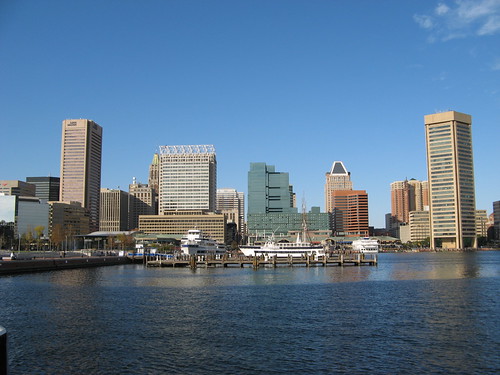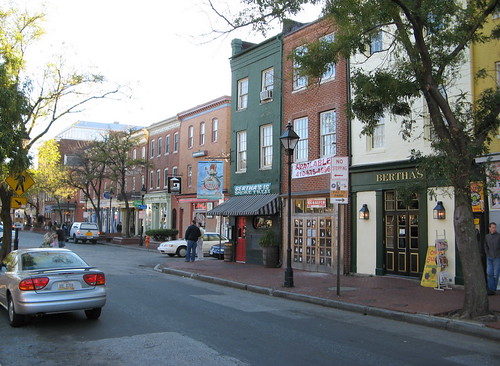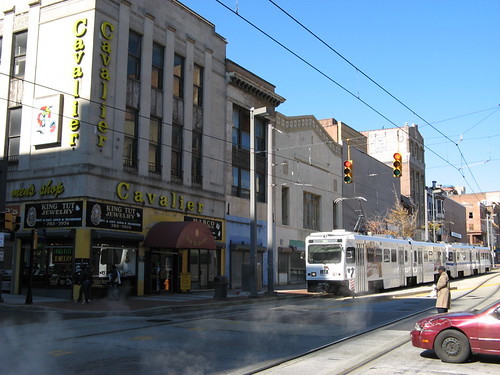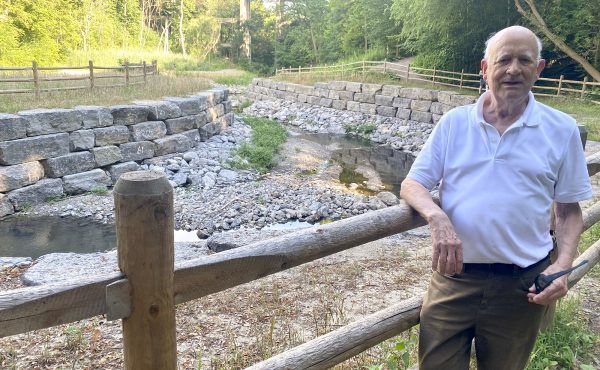
Following up (and inspired by) on Adam Chaleff-Freudenthaler’s post on walking in Washington, I happened to be in Charm City for a few days straddling Halloween for a conference. The only exposure to Baltimore’s cityscape was from watching that 1990s television crime-drama, Homicide: Life on the Street (the chilling 1997 episode “The Subway” is often regarded as one of the best single hours in dramatic television of recent years). Recently Toronto stood in for Baltimore, where the remake of the film version of the musical Hairspray was filmed.
Adam’s observation about Washington’s “contrast between wealthy tourist areas, communities in the process of revitalization and sorely depressed neighbourhoods” applies just as much in Washington’s nearest metropolitan neighbour. The contrast to Toronto, where the contrast between these areas is vast it is in DC.
Baltimore is about 65 percent African-American, largely due to white flight in the 1950s and 1960s and the migration by that community from the rural south to industrial centres during that period. The city is also notorious for crime – it consistently ranks in the top five most dangerous large cities in the United States. However, unlike many cities (Detroit immediately comes to mind), which have a struggling downtown with very few downtown residents, Baltimore has a fairly vibrant downtown with a vibrant waterfront. However, the racial divide is very much apparent: the neighbourhoods immediately surrounding the waterfront and in the north downtown were gentrified and mostly white (like the suburbs), but areas to the east and west much poorer and mostly populated by African-Americans [US Census Map] There is a lot of poverty in the city — the main employer, Bethlehem Steel, used to employ over 15,000 workers, what’s left of the plant barely employs one-fifth that.
Baltimore was one of the first US cities to attempt a downtown revitalization, which focused on its historic waterfront. In the 1970s, the only thing that would draw tourists was Fort McHenry, an early American fort protecting the city and its harbour. (During the War of 1812, British troops stationed in Canada burned Washington – including the White House – and tried the same in Baltimore. The successful American defence led to that country’s national anthem.)
 New condos in the downtown core.
New condos in the downtown core.
 The touristy Inner Harbor
The touristy Inner Harbor
The Inner Harbor, the centrepiece of Baltimore’s revitalization, was fixed up starting in the 1980s as part of the rejuvenation, which included the massive National Aquarium and a science museum. At the same time, a new subway was built. Later a new baseball stadium for the local team, the Orioles, incorporating an old railway warehouse and yards (hence the name, Camden Yards). The idea of having public museums on the water made the harbour interesting for tourists, but with glass-and-concrete pavilions full of chain stores, it seemed a bit too sterile. Though the area is popular with joggers.
The city also attempted to revitalize its housing stock to draw more people in. Dilapidated rowhouses (an architectural style dominant in the city) around the waterfront were taken over by the city, and sold for $1, with the condition that the houses be fixed up. Now some of the waterfront neighbourhoods have new condos and townhouses and are well-off and betwen 50 and 90% white, an interesting phenomenon for American cities. Washington is only 30-45 minutes away by car or train, making it an affordable urbanized alternative to Washington’s downtown or the suburbs. But go a few blocks away from the waterfront, and the streetscape changes fast. The only thing more dramatic that I have seen so far was the border between Detroit and Grosse Pointe, or between Gastown and East Hastings Street in Vancouver.
 Gentrifying rowhouses several blocks north of Fells Point
Gentrifying rowhouses several blocks north of Fells Point
I got out to a very nice pub outside the touristy Inner Harbor centre and in the more-local Fells Point neighbourhood. The Fells Point neighbourhood is amongst the most historic neighbourhoods in the city, and is very charming with brick roads, pubs in old houses and a small market square, the kind of streetscape lacking in Toronto. (Toronto’s Distillery District, which has some of these elements is being defaced with modern skyscrapers in and around the historic buildings) I even tried the local delicacy, crab cakes. Fells Point feels very authentic, with fewer tourists and more locals than around the central Inner Harbor district with its ESPN Zones, Ben and Jerry’s and California Pizza Kitchens.

 Fells Point
Fells Point
On the last full day I was in Baltimore, freed from the confines of the downtown hotel the conference was held at, I took a walk away from the harbour, planning to see Mount Vernon, a historic neighbourhood where the arts institutions are located. I first had lunch in Lexington Market, what seemed to me, the hidden heart and soul of the city, full of activity. The market is made up mostly of food stalls, selling everything from roast beef sandwiches to fresh fish, very similar to St. Lawrence Market here. The neighbourhood surrounding it, however, appears to be the old shopping district, now full of vacant stores and marginal business, as most of the investment (including new shopping) has migrated to the waterfront. The light rail runs a block away on blighted Howard Street, and has not enlived it, unfortunately.
 Howard Street, and BWI-destined light rail train.
Howard Street, and BWI-destined light rail train.
On Fridays, Lexington Market has live jazz and blues performances in the main seating area. There are stand-up tables in the middle, and upstairs, a balcony with seating. The market building is relatively modern, but in an old style — a market existed on the site since 1787. I bought lunch, which was relatively inexpensive, from a Hawaiian food kiosk. Lunch was grilled shrimp, with vegetables, rice and light radish sauce, not a lot different from what I would expect from an Asian meal, but the preparation was a bit different. The kiosk offered fresh fruit shakes -you could choose from a combination of strawberry, mango, papaya or lemon fruit.
 Lexington Market
Lexington Market
I stood at one of the tables watching the jazz. Some of it was real jazz, other songs were covers of classics like Marvin Gaye “What’s Going On”. Twice, people came up to my table and asked if they could share it, as the market was crowded. It was fortunate, as I was able to talk to locals. A couple came over, were a bit curious as to why I was there (I wasn’t a regular — lots of people there I noticed greeting each other, and didn’t have the local accent). I got into a conversation with them as I told them about Toronto. They were especially interested in how Toronto has over half its population made up of people who were born outside of Canada, and came from all over the world — China, Europe, the Middle East, India, Pakistan, the Caribbean, Latin America, and many have their own neighbourhoods, communities and festivals (the biggest being Caribana). I wasn’t trying to boast about Toronto, but as I talk to many people I meet in US cities, they get an impression I’m talking about an amazing city. It’s refreshing to get this response, because sometimes here, there still seems to be an inferiority complex, and we still keep hearing about how we have to become “world class”.
Mount Vernon, north of Lexington Market, is a tiny slice of New England or Europe. It is where there are several art galleries, the Peabody Institute, an art school, and a touch of gay culture, a few bars and shops catering to the small community. The library in the Peabody Institute is spectacular, as is the Catholic Basilica. Baltimore has some very nice pieces of architecture, and a few oddities, like the Bromo-Seltzer Tower (no kidding).
The first night I was there was Halloween. Edgar Allen Poe was raised here, and he died here, and buried in a cemetery which was later occupied by a church. The grounds are now owned by the University of Maryland. They hosted a Halloween night tour which was very well done, where you could tour the cemetery, including the catacombs — the graves covered by the church that was built later in the 19th century. An organist inside the church was dressed up and playing old horror movie classics, and there were regular readings of Poe’s work. The $5 admission included unlimited popcorn and apple cider.
I also used the light rail several times. It was useful for getting from the airport, and the price was right — only $1.60. It stopped two blocks from the hotel. I used it again coming back from Mount Vernon, and again on Saturday to get to Penn Station for a train to Washington. The trains come every 15 minutes, half that on the outer ends. The transit system, by US standards, is okay, but not great. There’s a subway (the subject of that Homicide episode), but it’s a single line with stations that feel overbuilt and underused, even with low service levels. Baltimore’s transit system is operated by the State of Maryland and the vehicles adorned with the Maryland flag, which is actually very attractive and almost as common as the American flag in Baltimore. After my visit to Washington (mostly hitting the tourist attractions), I took a train back to BWI Station, with a short shuttle ride to the terminal.
At that time, I though that Pearson should have a convenient, publicly funded, link to the nearby rail corridor that leads to Brampton and Kitchener. (The current Blue22 plan doesn’t cut it, but that’s another story).




11 comments
Is it just me, or is:
Baltimore is about 65 percent African-American, and consistently ranks in the top five most dangerous large cities in the United States.
a poor choice of two thoughts to combine into one sentence?
And I disagree with your offhand comment about the Distillery District. It wasn’t a vibrant historic neighbourhood (it sounds like Fells Point has been largely unchanged for decades); very recently it was an unused but historic industrial site. The company building the condos is the same one who imported bricks from Cleveland to restore the cobblestone streets. I don’t know the details of how the project has been financed, but it seems likely the condos are a major chunk of funding for the overall restoration; without them the whole place might still be nothing but a popular film set.
Matt: Good catch on the first point! They should have been separate points meant to compare/contrast with cities such as Detroit, which have similar characteristics but have not seen the same changes in the downtown core. I’ll fix that.
Secondly, I do not agree with the way the Distillery District is turning out with the tall condo buildings. I saw what could be done with a historic district in many places, including Fells Point. It’s unique architecture, and the businesses that have moved in are for the most part great (and their rent should help finance the revitalization). But for the new skyscraper tower that’s still in sales, one of the larger buildings in the complex (designated a National Historic Site) will be demolished. I think in the demolition, and the jarring difference in scale, the character of the district (which started out so nice with the theatre, galleries and pubs and Balzac’s) will be hurt badly by hemming it in with 30-40+ towers, and the demolition of one building there, the large Rackhouse, is a defacement to say the least.
Baltimore sounds like it’s about on the same cosmopolitan level as Portland, Oregon. Not quite a great American metropolis (NY, Chi, SF, Boston, LA*), but definitely a livable place with a decent downtown and a certain amount of charm. Having excellent rail connections to DC and Philly is an added bonus.
The Fells Point neighbourhood looks fantastic. I love those rowhouse neighbourhoods that come right up to the street. If the Toronto fire department wasn’t so paternalistic, we could be building laneway housing just like that.
*Yes, LA is one of the ‘greats’.
Saw this psychogeographic book reviewed in the NYTimes a couple weeks ago that seems like it would make a good Baltimore companion:
http://www.nytimes.com/2007/12/16/books/review/Kamine-t.html?_r=1&oref=slogin
I’ve actually recently become intruiged by Baltimore because I’ve decided to re-visit watching Homicide (Just started S4), and strangely despite it’s bleak portrayal of the city, to me it’s really made me interested in a visit. The neighbourhoods and character seem very “authentic” which I find has been increasingly hard to find in Toronto. Anyhow, for anyone interested in great episodic television and who want to catch some great glimpses of Baltimore I can’t recommend Homicide any more highly.
Matt,
Blacks make up less than 15% of our national population but 90% of the violent crime. Hello….these are facts. IT IS WHAT IT IS!
Hey, yet another mess of a city that somehow still has airport rail access when Toronto doesn’t. I’m in Chicago in the moment, which unfortunately exceeds Toronto in every urban category you can think of (including condo development, something I never thought I would see), and had the same what-the-hell-is-wrong-with-Toronto thought while riding in the Blue line from O’Hare. I’ll no doubt think about it again no doubt while riding the Orange Line out to Midway.
I also did not mention that I live 20 minutes away and work in the city. In fact my office is incompassed by one of if not the worst areas in Baltimore. This area was featured on HBO’s the Wire.
uSkyscraper> Have you been through the miles and miles of Chicago’s devastated south side? Seen the big box stores in-and-around innercity neighbourhoods like Ukranian Village and Bucktown? That certainly exceeds Toronto in certain urban categories too, non?
(just cautioning the oft mentioned but seldom fully interrogated “xxxx city is better than Toronto in every category” sentiment that comes up from time to time)
I’m a Toronto booster, despite my often snarky comments, and I did cleverly leave room in my description to admit that yes, Chicago’s negative aspects do indeed exceed Toronto’s. However, the postive aspects of the city were quite overwhelming and most impressive and formed the basis of my opinion.
For the record, I did tour the south side quite a bit, from the Near South down to Hyde Park, and also over by IIT. I also poked around the former Cabrini Green on the west side. Some areas were quite improved from their appearance in Camilo Jose Vergara’s books. There has been quite a bit of change in recent years, and the old stereotypes are no longer entirely true (just as the old saw about Toronto being the cleanest city in North America isn’t worth the litter it is printed on). You might be surprised at the pace of change.
The newest of the big-box stores in the South Loop and off Clybourn were in fact not bad and very well integrated into the area, while the boutique stores of Lincoln Park uniformly had beautiful signage and products and spoke of the city’s great prosperity. I would take the South Loop Whole Foods complex over Laird Drive in Leaside, or Armitage Street over Bloor W Village any day.
I would encourage any proud Torontonian to visit Chicago and pick up on the city’s recent improvements to see how to apply them to Toronto. It may not be feasible to match Chicago’s excellent bones of wide streets, large population, great wealth and supertall buildings but there are many smaller touches that would be great additions for Toronto.
I am very careful when throwing around the “better than Toronto” phrase, but Chicago was truly an eye-opener.
Hey, Baltimore native here. Found this post while googling for something totally different. Glad ya had fun down here.
The light rail is limited, but it works. Feel lucky you didn’t have to navigate the bus system. And it’s kind of funny how many different ways there are to get to DC through MTA–I know of at least three.
Lexington Market…haven’t been there since I was like five. It’s in a pretty iffy part of town. Cross Street Market is where the real fun is. It’s by Federal Hill, much further from viable transit, but it’s a fun trip.
And even though those museums on the harbor seem touristy, some of them are pretty awesome. The National Aquarium is among the best in the country. The USS Constellation has been afloat since the 1860’s. The Maryland Science Center got renovated not long ago. And did you drop by the American Visionary Art Museum–that’s some crazy stuff in there.